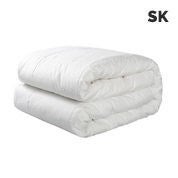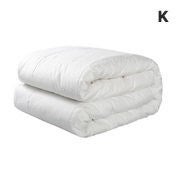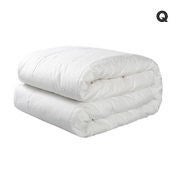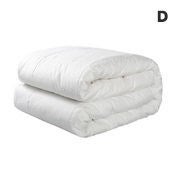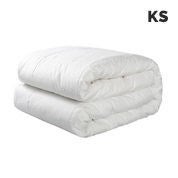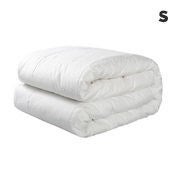 RRP
RRP
 WAS
WAS

 WAS
WAS
 WAS
WAS
 WAS
WAS
 WAS
WAS
 WAS
WAS
 RRP
RRP
 WAS
WAS
 RRP
RRP
When it comes to creating a comfy bed, quilts and duvets are absolutely essential. They play a huge part in how your bed looks and feels and contribute significantly to your comfort, the warmth you need, and the overall style of your bedroom. Choosing the right bedding is important. It's for making sure you're comfortable and get good quality sleep, along with expressing your personal style. You should be able to adjust your bedding easily for seasonal changes – like swapping from a lighter covering in a humid summer to something much toastier in winter. Understanding the differences between quilts and duvets is also crucial before you make a purchase, as they each offer unique benefits for your sleeping setup.
What Is the Difference Between a Quilt and a Duvet?
While both quilts and duvets are designed to keep you warm, they have distinct constructions and typical uses. Let's break them down.
A quilt is a very traditional piece of bedding. It's constructed by carefully stitching together multiple layers of fabric with a soft inner filling (like cotton batting or wool) in between. What really makes a quilt stand out are its distinctive patterns and designs, which are created by the way the fabric pieces are sewn together or by the decorative stitching that holds the layers in place. Quilts are typically used as lightweight bedding, perfect for warmer nights, or as decorative layering pieces folded at the foot of the bed to add texture and colour.
A duvet is essentially a soft, flat bag that's filled with insulating materials like down, feathers, wool, or synthetic fibres. Unlike a quilt, a duvet is almost always designed to be used with a removable cover, which is called a duvet cover. This system works brilliantly: the duvet itself provides the warmth, while the cover protects it, adds style, and can be easily taken off for washing. This means you only need one duvet, but you can change its look simply by swapping out the cover, making it super convenient.
They also differ based on:
-
Weight and Warmth Level: Quilts tend to be lighter and offer less insulation, making them ideal for milder temperatures or as an extra layer. Duvets, on the other hand, usually offer superior insulation and are designed to be the primary source of warmth, often feeling much loftier and warmer.
-
Maintenance and Cleaning: This is a big one! Duvets are much easier to keep clean because their covers are removable and washable. You typically wash the cover regularly, while the duvet itself needs less frequent cleaning (and often requires professional dry cleaning). Quilts, because all their layers are stitched together, generally require more careful cleaning, sometimes needing a larger machine or professional services.
-
Layering Possibilities: Quilts are fantastic for creating a layered look, adding visual interest and texture to your bed. Duvets, wrapped in their covers, offer a simpler, cleaner aesthetic, often creating a fuller, more plush look.
How to Choose Between a Quilt and a Duvet
Climate and Seasonal Considerations
-
If you're in a warmer climate or heading into those mild spring and summer months, quilts are often a great choice. They're generally lighter and provide just enough warmth without making you feel overheated.
-
For cold temperatures, duvets are usually a better option. They offer superior insulation and can be found with various fills, so you can pick one that's super cosy and warm, keeping you snug even on the chilliest nights.
Personal Comfort Preferences
-
Do you like a lighter covering that feels airy, or do you prefer the comforting hug of a heavier blanket? Quilts tend to be lighter, while duvets offer more loft and can feel more substantial.
-
Some people sleep hot, others sleep cold. Duvets offer a wider range of warmth levels through different fillings and fill powers, making it easier to tailor to your specific needs.
-
Are you someone who likes to kick a leg out? Do you shift around a lot? The flexibility and drape of each can matter.
Cleaning and Maintenance Needs
-
Quilts are generally easier to use as a single piece, but when it comes to washing the whole thing, they might require a larger washing machine or even professional cleaning due to their stitched-together layers.
-
Duvets, on the other hand, are designed for their ease of cleaning. You simply take off the duvet cover and toss it in the wash regularly. The duvet insert itself needs much less frequent cleaning, though depending on the filling, it might also require delicate care or professional cleaning eventually. This convenience is a big draw for many busy households.
Allergies and Sensitivities
For allergy sufferers, hypoallergenic options are available for both quilts and duvets. This often means choosing synthetic fills (like polyester) over natural feathers or down, as these are less likely to trigger reactions.
It's also worth looking at the fabric type of the outer shell or cover. Tightly woven natural fibres or specific allergen-barrier fabrics can help too.
Materials Used in Quilts and Duvets
Quilts, with their layered construction, often use a variety of materials for both the outer fabrics and the inner filling:
Outer Fabrics (Tops and Backs)
-
Cotton: This is by far the most popular choice for quilt fabrics. It's naturally breathable, soft, and durable, making it comfortable in various temperatures. Cotton also takes dyes beautifully, allowing for those distinctive patterns.
-
Polyester Blends: Often used for their durability, wrinkle resistance, and affordability. They can sometimes feel less breathable than pure cotton.
-
Silk Blends: For a touch of luxury, silk offers a wonderfully smooth and soft texture, excellent breathability, and a beautiful drape.
Inner Filling (Batting)
-
Cotton: Provides good breathability and a flatter, often denser feel.
-
Wool: Offers excellent warmth for its weight, is naturally breathable, and can regulate temperature well.
-
Polyester: A common synthetic fill, it's lightweight, hypoallergenic, and provides good loft and warmth.
-
The choice of these materials directly influences the quilt's breathability (how well air flows through it), its warmth level, and the overall texture and feel when you snuggle up with it.
Common Duvet Fillings
-
Down: These are the soft, fluffy clusters found under the feathers of ducks or geese. Down is highly prized for its exceptional lightweight warmth, breathability, and ability to trap air, creating excellent insulation. It's incredibly soft and moulds beautifully around you. However, it can be more expensive and might not be ideal for those with feather allergies.
-
Feathers: Often combined with down, feathers provide more weight and firmness to the duvet. They're a bit heavier and less lofty than pure down but offer good warmth and are generally more affordable than pure down.
-
Wool: A natural fibre, wool is fantastic for temperature regulation. It can keep you warm in winter and cool in summer by wicking away moisture. Wool duvets tend to be heavier than down but are often hypoallergenic and very durable.
-
Synthetic Fibres (e.g., Microfiber, Polyester): These are man-made alternatives designed to mimic the feel of down. Microfiber is particularly known for its softness and fine texture. Synthetic fills are generally hypoallergenic, more affordable, and easier to wash than natural fills, making them a great choice for allergy sufferers or busy households.
Quilting Techniques and Impact on Function
-
Loft: How fluffy and airy the bedding feels. Different stitching patterns can allow the fill to loft up more or compress it.
-
Durability: Well-executed stitching prevents the filling from clumping or shifting over time, which ensures the warmth is evenly distributed and the bedding lasts longer.
-
Breathability: The stitching can also influence airflow within the bedding. Common patterns include box stitching (creating individual pockets for fill), baffle box construction (using fabric walls to create more generous pockets for maximum loft), or channel stitching.
Fabric Types for Covers and Outer Layers
-
Cotton Percale: Known for its crisp, cool, and matte finish. It's breathable and feels like a classic, fresh bed sheet.
-
Cotton Sateen: Offers a silkier, smoother feel with a slight sheen. It's soft and drapes beautifully, often feeling a bit warmer than percale.
-
Linen: A natural fibre with a unique texture. Linen is incredibly breathable, moisture-wicking, and gets softer with every wash. It has a relaxed, effortlessly chic look.
-
Flannel: A brushed cotton fabric that provides extra warmth and a soft, cosy feel, perfect for cooler nights.
Popular Categories:
Quilts & Duvets Reviews
-
13 days ago
The duvet is good value and surprisingly warm.
Wispy
-
6/08/2025
A very light but warm doona, bought last month. This replaces all my blankets because of the warmth. I also have the electric blanket on one instead of three, just to warm the bed before retiring. It has been unusually cold this year so it has proven worthy of purchase, with a good price.
Pjm
-
5/08/2025
Warm and comfortable. 💯 %happy. Thank you 😊
101
-
5/08/2025
I’m a hot sleeper even during winter and 500gsm is good for sydney raining cold winter night
Mils
-
3/08/2025
This is the second one l have purchased One for my son and was so impressed with the quality Beautiful doona so warm Highly Recommended
Sienna
-
2/08/2025
I bought this a couple of weeks ago because I wasn't happy with the bulky doona I had. So far it has kept me nice and warm.
Vince
-
1/08/2025
Very nice, not to heavy. Great.
Plantman
-
30/07/2025
ery happy brought Doona for my mother - she is very happy with purchase
AnneR
-
26/07/2025
Haven't used yet but looks good
Chappo
-
24/07/2025
I have been using this doona for 2 weeks now and I love it. I was concerned it would not be as warm as my wool doona but I was happily surprised. It is beautifully warm and so much lighter. Great price
Connie
-
24/07/2025
Light and fluffy great for all seasons
Jodi
-
24/07/2025
Bought the larger size to cover the sides of the king bed. Happy I did as it keeps us cosy warm.
Solmum
-
24/07/2025
Very happy with this purchase.
Solmum
-
24/07/2025
Very soft & super warm!! I’m very happy with my purchase :-)
Haych
-
22/07/2025
Gloriously fluffy and warm
Ceeje1977




